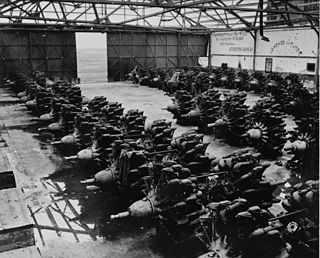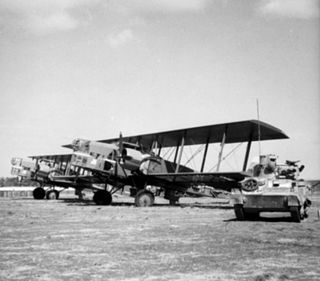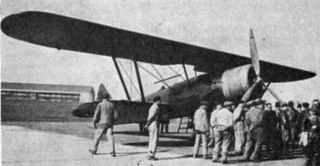
The Amiot 143 was a 1930s French 5-seat Multiplace de Combat (M.5) designed to meet 1928 specifications for a monoplane capable of day and night bombing, long-range reconnaissance and bomber escort.

The Société des Avions Marcel Bloch was a French aircraft manufacturer of military and civilian aircraft. It was founded by the aeronautical designer Marcel Bloch, who had previously played a major role in the Société d'Études Aéronautiques, an early French aircraft manufacturer active largely during the First World War.

The Bloch MB.210 and MB.211 were the successors of the French Bloch MB.200 bomber developed by Société des Avions Marcel Bloch in the 1930s and differed primarily in being low wing monoplanes rather than high wing monoplanes.

The Bloch MB.170 and its derivatives were French reconnaissance bombers designed and built shortly before the Second World War. They were the best aircraft of this type available to the Armée de l'Air at the outbreak of the war, with speed, altitude and manoeuvrability that allowed them to evade interception by the German fighters. Although the aircraft could have been in service by 1937, debate over what role to give the aircraft delayed deliveries until 1940.

The Potez 630 and its derivatives were a family of twin-engined, multirole aircraft developed for the French Air Force in the late 1930s. The design was a contemporary of the British Bristol Blenheim and the German Messerschmitt Bf 110.
The Bréguet 690 and its derivatives were a series of light twin-engine ground-attack aircraft that were used by the French Air Force in World War II. The aircraft was intended to be easy to maintain, forgiving to fly, and capable of 480 km/h (300 mph) at 4,000 m (13,000 ft). The type's sturdy construction was frequently demonstrated and the armament was effective. French rearmament began two years later than that in Britain and none of these aircraft were available in sufficient numbers to make a difference in 1940.

The Farman F.220 and its derivatives were thick-sectioned, high-winged, four engined French monoplanes from Farman Aviation Works. Based on the push-pull configuration proven by the F.211, design started in August 1925 and the first flight of the prototype was on 26 May 1932. The largest bomber to serve in France between the two world wars was the final F.222 variant. One variation was intended to be an airliner.

Lioré-et-Olivier LeO 45 was a French medium bomber that was used during and after the Second World War. It had been designed for the new Armée de l'air as a modern medium bomber capable of performing independent strategic operations, unlike the majority of previous French bombers.

Potez 25 was a French twin-seat, single-engine sesquiplane designed during the 1920s. A multi-purpose fighter-bomber, it was designed as a line aircraft and used in a variety of roles, including fighter and escort missions, tactical bombing and reconnaissance missions. In the late 1920s and early 1930s, Potez 25 was the standard multi-purpose aircraft of over 20 air forces, including French and Polish. It was also popular among private operators, notably mail transport companies.

The Gnome-Rhône 14K Mistral Major was a 14-cylinder, two-row, air-cooled radial engine. It was Gnome-Rhône's major aircraft engine prior to World War II, and matured into a highly sought-after design that would see licensed production throughout Europe and Japan. Thousands of Mistral Major engines were produced, used on a wide variety of aircraft.

The Bréguet 521 Bizerte was a long-range military reconnaissance flying boat built by the French aviation company Breguet.

The Dewoitine D.338 was a 1930s French 22-passenger airliner built by Dewoitine. The D.338 was late 1930s airliner of France and served on long-distance routes, when WW2 came it was pressed into military service.
The Latécoère 611 was a French four-engined maritime reconnaissance flying boat of the Second World War. Although only a single prototype was completed, this served throughout the war, being used by both the Vichy French and Free French navies.

The Potez 540 was a French multi-role aircraft of the 1930s. Designed and built by Potez, it served with the French Air Force as a reconnaissance bomber, also serving with the Spanish Republican Air Force during the Spanish Civil War. Although obsolete as a bomber, it remained in service in support roles and in France's overseas colonies at the start of World War II.

The Potez 62 was a French twin-engine civil airliner, designed by Henry Potez in 1934. The French military adapted this airframe two-years later to create the Potez 650.

The Morane-Saulnier MS.230 aircraft was the main elementary trainer for the French Armée de l'Air throughout the 1930s. Almost all French pilots flying for the Armée de l'Air at the outbreak of World War II had had their earliest flight training in this machine. It was the equivalent of the Stearman trainer in the United States air services and the de Havilland Tiger Moth in the British Royal Air Force.

The SNCASE SE.100 was a French two-seat, twin-engined fighter that first flew in 1939. Mass production was planned to begin late in 1940 but the Fall of France prevented this.

The Lioré et Olivier LeO 25 was a bomber aircraft produced in France in the late 1920s.

The Potez 50 or Potez 50 A2 was a French two seat military multi-role aircraft, first flown in 1931. It did not go into service but seven variants using five different engines were produced, one of them setting several speed with useful load records and another, the Potez 506, setting three altitude world records.
The Dewoitine HD.780 was a prototype French fighter-floatplane designed and built from 1938–40. It was a single-seat, single-engined aircraft based on the Dewoitine D.520 land-based fighter. A single example was built but was abandoned unflown, and was scrapped.

















